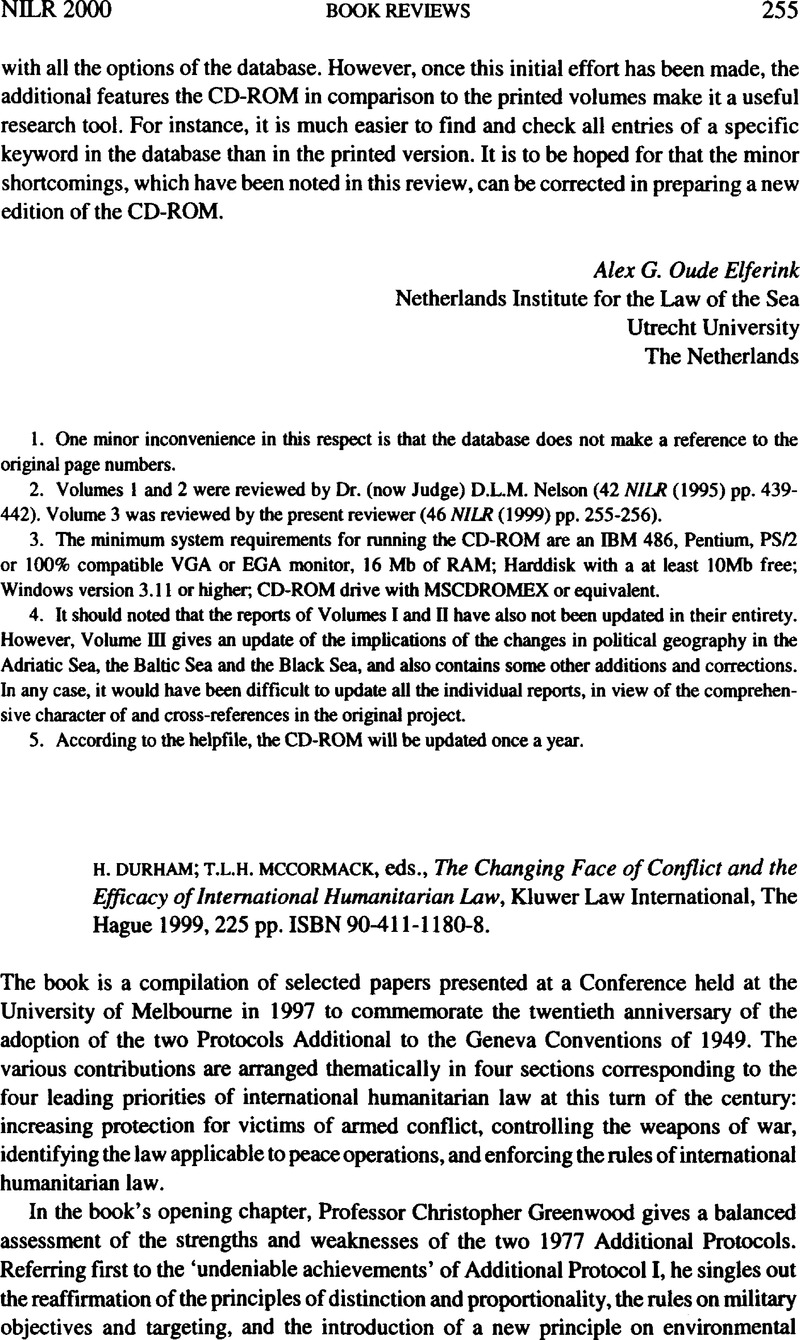No CrossRef data available.
Published online by Cambridge University Press: 21 May 2009

1. The case for a new instrument is also made in Askin, K.D., ‘Sexual Violence in Decisions and Indictments of the Yugoslav and Rwandan Tribunals: Current Status’, 93 AJIL (1999) pp. 97–123.CrossRefGoogle Scholar
2. In May 1999, the ICRC convened a meeting of government experts to consider the proposals contained in the SIrUS project, while in November 1999 the 27th Conference of the Red Cross and Red Crescent included the SIrUS project into the Plan of Action for the years 2000–2003 by encouraging states to analyse the extent to which the project could be of assistance; see 81 International Review of the Red Cross (Dec. 1999) No. 836, p. 887.Google Scholar
3. As Frits Kalshoven has argued, the codified principles on weapons use cannot provide standards that could simply be applied to existing and possible future weapons, but at most can serve as guidelines – ‘as guidelines they need provide little more than a set of basic, perhaps usually conflicting considerations that must be weighed in arriving at a decision’; see ‘The Conventional Weapons Convention: Underlying Legal Principles’, 279 International Review of the Red Cross (1990) p. 517Google Scholar. Cf., , Henri Meyrowitz for whom the superfluous injury concept goes beyond that of a source of inspiration, enjoying the status and role of a directing principle and not merely a moral principle; see ‘The Principle of Superfluous Injury or Unnecessary Suffering’, 299 International Review of the Red Cross (1994) p. 117.Google Scholar
4. The intricacies of the superfluous injury/unnecessary suffering concept are best analyzed in Ch. Greenwood, ‘The Law of Weaponry at the Start of the New Millennium’, in M.N., Schmitt and L.C., Green, eds., The Law of Armed Conflict: Into the Next Millennium (Newport, RI, Naval War College 1998) pp. 194–199.Google Scholar
5. The document was finally released on 6 August 1999 in the form of a Secretary-General's Bulletin entitled ‘Observance by United Nations forces of international humanitarian law’ (ST/SGB/1999/13). It can be accessed in <www.un.org/peace/>. See also the relevant ICRC statement, dated 20 October 1999, at the 54th session of the UN General Assembly in <www.icrc.org/eng/statements>.
6. See, for instance, Shraga, D., ‘The United Nations as an Actor Bound by International Humanitarian Law’, in L., Condorelli, ed., Les Nations Unies et le droit international humanitaire, (Paris, Pedone 1996) p. 337Google Scholar, and the congruent remarks by C. Emanuelli, F. Hampson and Th. Meron, ibid., at pp. 369, 395, 444. In the same vein, see also Greenwood, Ch., ‘International Humanitarian Law and United Nations Military Operations’, 1 YIHL (1998) p. 22, andCrossRefGoogle ScholarBenvenuti, P., ‘The Implementation of International Humanitarian Law in the Framework of United Nations Peace-keeping’, in Law in Humanitarian Crises, Vol. I (Luxemburg, Office for Official Publications of the European Communities 1995) p. 111.Google Scholar
7. Section 1.1 on field of application reads in part: ‘The fundamental principles and rules of international humanitarian law set out in the present bulletin … are applicable to enforcement actions, or in peacekeeping operations when the use of force is permitted in self-defence’ (emphasis added). See also the commentary by Ryniker, A., ‘Respect du droit international humanitaire par les forces des Nations Unies’, 81 International Review of the Red Cross (Dec. 1999) No. 836, pp. 795–805.Google Scholar
8. See, for instance, the 1968 UN Convention on the Non-Applicability of Statutory Limitations to War Crimes and Crimes Against Humanity and the 1974 Council of Europe Convention on the same subject. See also the International Law Commission's commentary on draft Art. 5 of the Draft Code of Offences Against the Peace and Security of Mankind, ILC Yearbook (1987–II) part two, pp. 15–16. On the French doctrine of imprescriptibilité as applied in the Touvier and Barbie trials (including bibliographical references), see Sadat Wexler, L., ‘The Interpretation of the Nuremberg Principles by the French Court of Cassation: From Touvier to Barbie and Back Again’, 32 Columbia Journal of Transnational Law (1994) pp. 318–322.Google Scholar
9. In the felicitous words of Bassiouni, C., ‘sympathy for victims of international crimes, no matter how sincere or widespread, is meaningless. Indignation by itself is never enough. Retributive and restorative justice is what makes sympathy meaningful and indignation credible’; see ‘Policy Perspectives Favoring the Establishment of the International Criminal Court’, 52 Journal of International Affairs (1999) p. 797.Google Scholar